| |
|
Forgotten Temples of Kashmir
Photo series Part-11 An effort to preserve and record Hindu cultural and religios heritage of Kashmir Mata Bhuvaneshwari….Chandpora (Harwan) 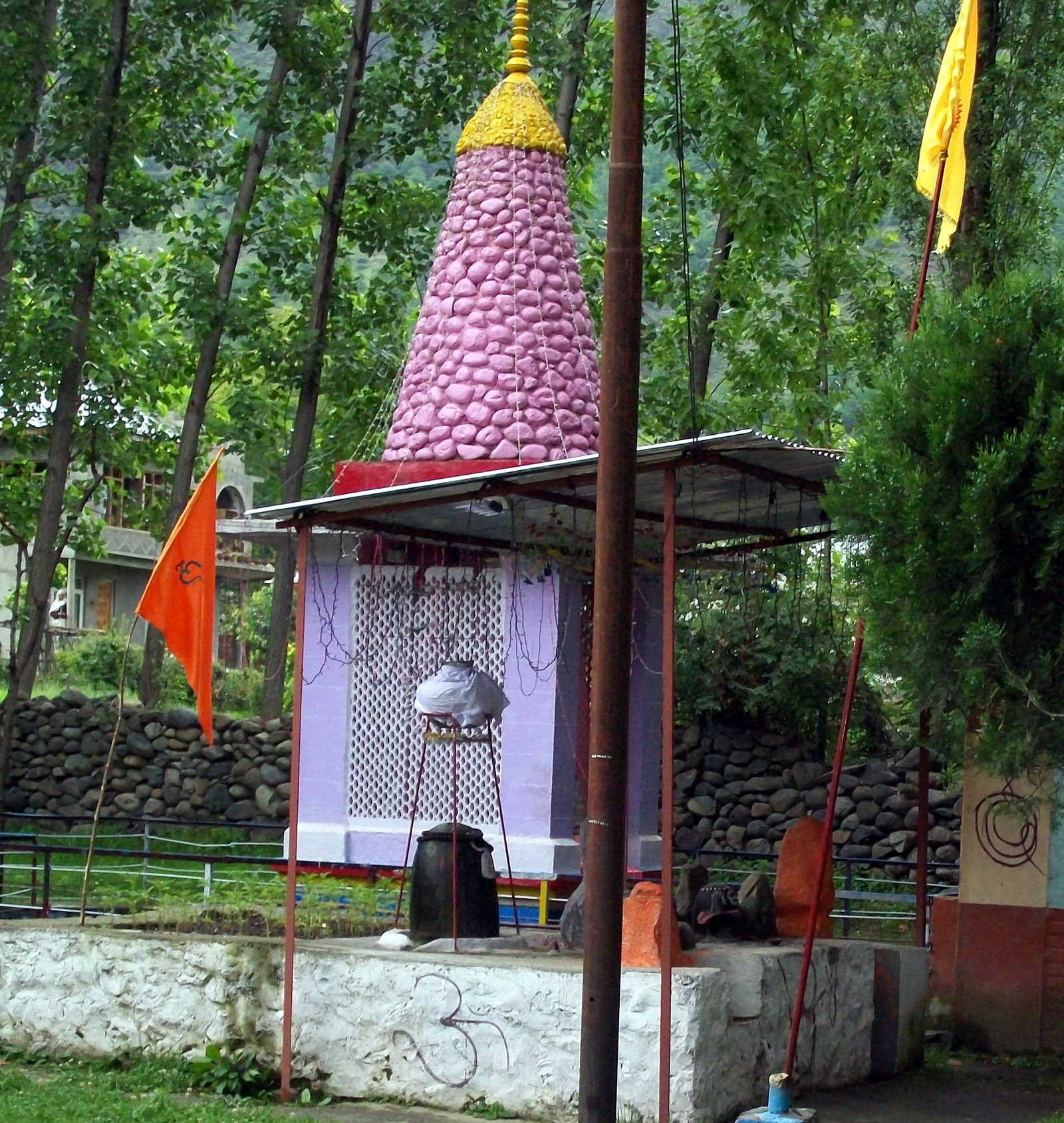
Exclusive images and report from a remote village in Kashmir provided for Shehjarby Chander M. Bhat |
| Harwan is a huge garden lined with flower beds and massive Chinar Trees with a beautiful canal flowing right through the middle. The canal is fed from a beautiful lake which lies behind the garden. There is not much clutter of fountains and other fancy things but vast big green carpeted green lawns which form an ideal spot for picnics. Kalhana maintains in his Raj Tarangini that "there is not a piece of land, equal to a mustard seed that is not a tirtha in Kashmir". It is on this account that the Aryans visited Kashmir frequently; they stayed mostly at Buzahama and Harwan. On a hillock, linked with the name of Raja Harish Chandera (known for his honesty), there still exist some ancient ruins considered sacred. At Harwan, in Chandpora, there is a small sacred spring associated with Mata Bhuvaneshwari. Kalhana has mentioned this spring in the Raj Tarangni; at two of its corners, we find the idols of Mata Bhuvaneshwari installed. It is said that it was Maharaja Gulab Singh who changed the original name of the place from 'Chachaa Pora' to Chand Pora. The Maharaja's grandson Maharaja Partap Singh often visited the sacred spot and paid his obeisance to the Holy Mother; as a religious ritual, he would feed young virgins and adore them as divinities. The hillock of Mahadev, believed to be the abode of Lord Shiva is about 20 kilometers away from the holy spring located in Chandpora. It is believed that Lord Shiva keeps a vigil on it from the Mahadev Peak. It was during Maharaja Partap Singh's reign that a Sadhu Alakh Ram took up his abode in a hut near the spring mentioned above. The hut got destroyed in a fire. Thereafter two Dharmshallas were constructed to provide shelter to pilgrims, these structures did not stand the fury of nature for long and no trace was left of them. With the expansion in the population of the village around, the inhabitants got together and constituted a committee to look after the shrine, which they named as Bhuvaneshwari Sathapana Committee. The members of the committee in question spared no efforts in raising a pucca structure that served as a Dharmshalla accommodating at least 200 pilgrims. The committee in question not only renovated the spring but also got a concrete temple built up in which the image of the Mata was firmly installed. In the adjoining area of the temple, measuring 3 kanals of land, there exist six Chinar trees and a brook having pure water flows through the complex. It is said that a spring has sprouted from within the hollow of each of these Chinars. The water of the main spring at the shrine can cure diseases. The legend is there that once the only son of a woman, who had gone blind, reposing his trust in the kind heartedness of the Mother Goddess Bhuvaneshwari, washed his eyes with the water of the holy spring for seven consecutive days; he regained his vision through the grace of virgin Goddess Mata Bhuvaneshwari, whose devotees make only vegetarian offerings to her in the shape of the fruits and other edible things. Non vegetarian offerings to the Goddess are strictly forbidden. Mata Bhuvaneshwari, is one of the seven sister-divinities and the youngest of them, the other six being Ragyna, Sharika, Jawala, Zeshta, Uma and Shardha. According to Kashmir, Shivism, Shiva, who is the male counterpart of the Shakti, is the Supreme Being. He remains introvert and dormant, while Shakti is active and dynamic. The Shaivite philosophy is, in principle, non dualistic. In her diverse manifestations, Shakti performs manifold functions. As Saraswati, she propagates knowledge and wisdom. As Lakshmi, she distributes wealth and as Kali she destroys the demons. In Kashmir, Shakti worship is very popular and every clan of Kashmiri Pandits adores its chosen female deity as Ragyana, Sharika, Jawala, Zeshta, Uma, Sharda or Bhuvaneshwari. Being the youngest, Bhuvaneshwari, is adored as eternal Shakti. The devotees in great bulk, including all the inhabitants of Chandpora, have deep-rooted faith in Bhuvaneshwari. It is said that when a hawan was performed propitiate the Goddess Bhuvaneshwari on the seventh day of it a beautiful snake, bearing white patches, emerged all at once from the spring at Chandpora, it made seven circumambulation around the temple to the joy of devotees present there. It accepted the milk that was offered to it by the devotees, and then vanished. The devotees took it as a good augury, believing firmly that Bhuvaneshwari had blessed them. Thus enthused and encouraged, a beautiful Murti (idol) of the Goddess carved out of the marble from Jaipur was installed in the temple on Mata’s Birthday in the year 1974, falling on Vetha Truvah which is also celebrated as the birthday of the river Vitasta (Jhelum) annually. It was the late Swami Laxman Joo, renowned saint and Shavite Scholar, who took care of the installation ritual. After the displacement of the Pandits from the Valley, the devotees of the Mata being away could no longer ensure the preservation and maintenance of the shrine. With the passage of time, due to climatic ravrages the Dhramshala collapsed, though, the other pacca structures still exist. Now the Mata's hawan is being performed at the Kheer Bhawani Peeth at Janipur, Jammu to mark the birthday of Bhuvaneshwari. Notes and References 1. Place Names in Kashmir by B.K.Raina and S.L.Sadhu published by Bharatiya Vidya Bhavan, Mumbai and Indira Gandhi National Centre for the Arts, New Delhi, 2000 edition. 2. Bujbror…An Ancient Religious Place by Sh. P.N.Bhat published in Koshur Samachar. 3. Encyclopedia: Kashmiri Pandit Culture and Heritage by C.L.Kaul, published by Ansh Publications, New Delhi, 2009 edition. |
| Icons in open in the lawns of the shrine |
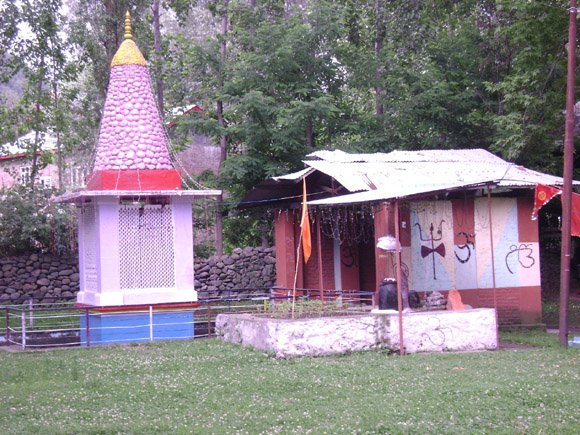
Lawns of the Shrine |

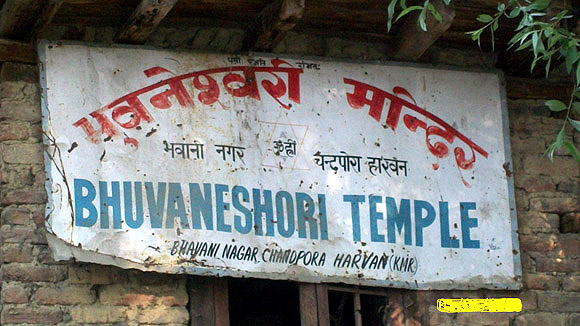
See the scars of stones on my face |
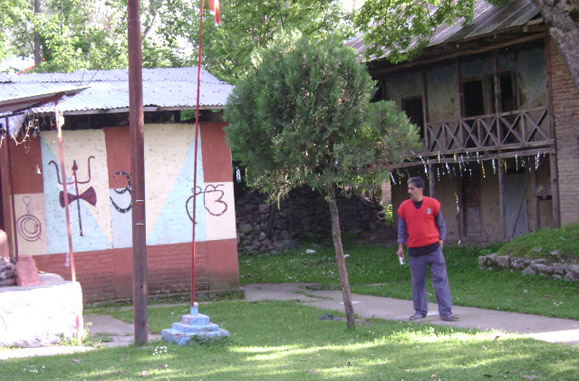
Author in the lawns of the shrine trying to collect the scattered pieces of history |
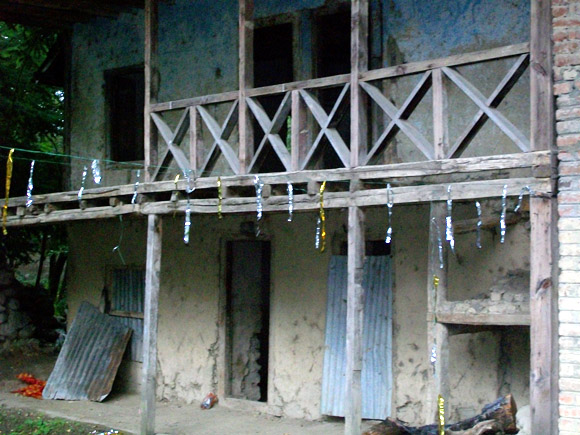
Old Dharamshala adjacent to the temple. All the doors and windows open like a wound |
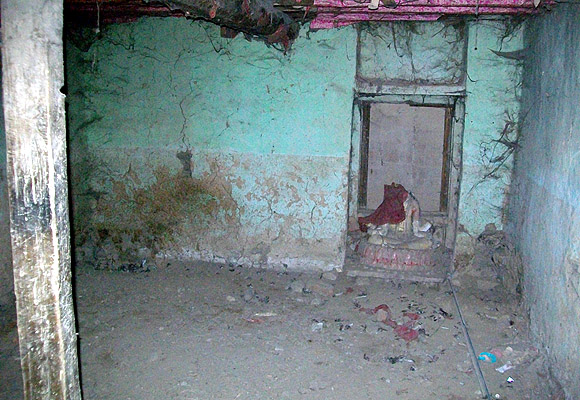
Inner view of the room of old Dharamshala |
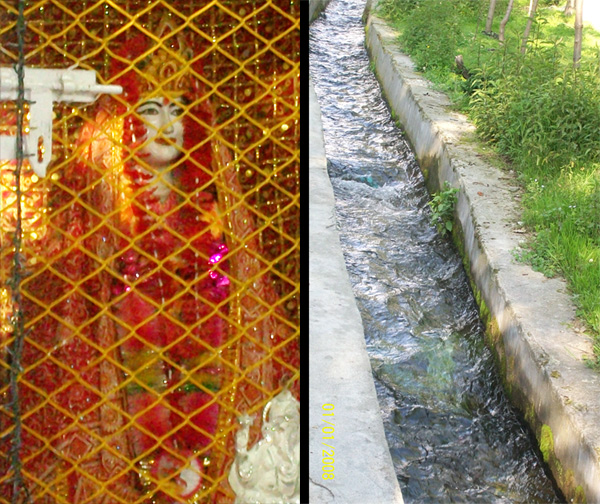
aMata Bhuvaneshwari |
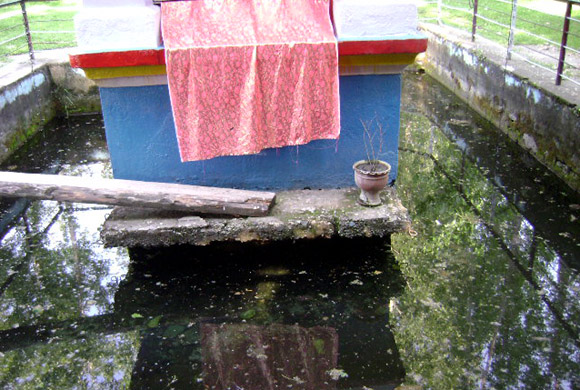
Close view of the Holy Spring |
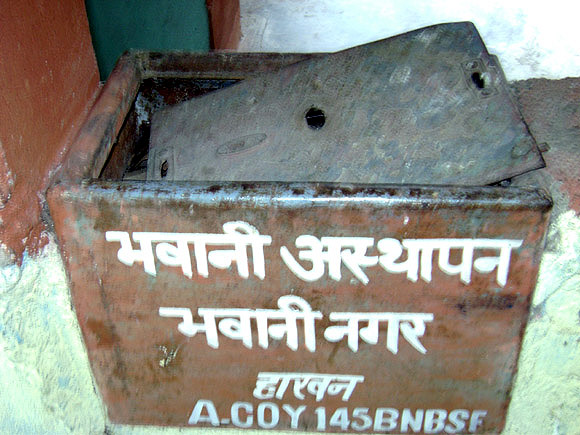
I was opened forcibly, by big hammers |
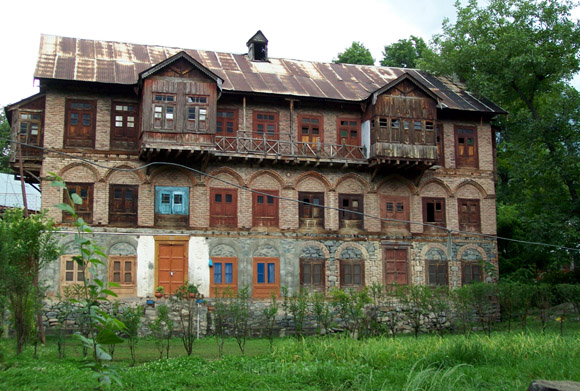
A Kashmiri Hindu house adjacent to the Shrine |
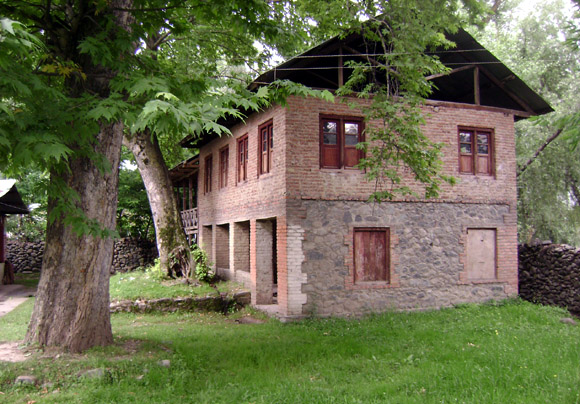
Newly constructed Dharamshala. Doors and windows are open |
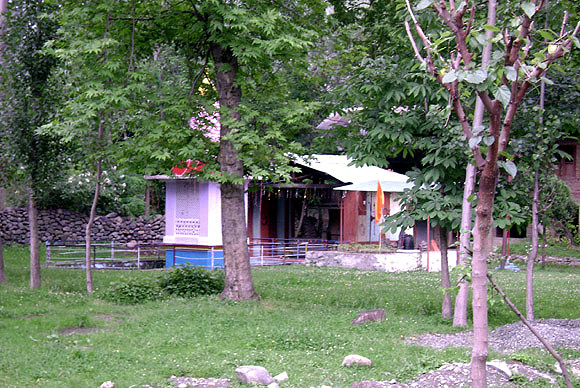
Shrine in the shambles |
| |
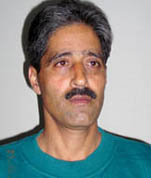 *Born on 20th March, 1960 in Murran a village in North Kashmir,
Chander M. Bhat is presently working as an Assistant Supdt. Posts, in
Department of Posts, Govt. of India. His articles regarding Posts and of
non-political nature stand widely published in various papers and
magazines of the country. A booklet 'How to Collect Stamps" published by
the Department of Posts, has earned him genuine accolades. He worked on
the project of tracing the roots of his co-villagers and of the village
Murran, resulting into the culmination of a widely acclaimed book
"Murran -My Village". Man with depth, Chander M. Bhat has also another
book, "Ocean by Drops" (collection of poems) in his vase having colorful
poems. His book "Ancient History of Jammu and Kashmir", confirms his
researching capability. Various research papers like "The Splendor that
is Amarnath" and "Vitasta" The Sacred River of Kashmir" are valuable
additions to his works that has proved very fruitful and guiding force
in the exile period of Kashmiri Pandits community of which the author is
also a member.
*Born on 20th March, 1960 in Murran a village in North Kashmir,
Chander M. Bhat is presently working as an Assistant Supdt. Posts, in
Department of Posts, Govt. of India. His articles regarding Posts and of
non-political nature stand widely published in various papers and
magazines of the country. A booklet 'How to Collect Stamps" published by
the Department of Posts, has earned him genuine accolades. He worked on
the project of tracing the roots of his co-villagers and of the village
Murran, resulting into the culmination of a widely acclaimed book
"Murran -My Village". Man with depth, Chander M. Bhat has also another
book, "Ocean by Drops" (collection of poems) in his vase having colorful
poems. His book "Ancient History of Jammu and Kashmir", confirms his
researching capability. Various research papers like "The Splendor that
is Amarnath" and "Vitasta" The Sacred River of Kashmir" are valuable
additions to his works that has proved very fruitful and guiding force
in the exile period of Kashmiri Pandits community of which the author is
also a member.Presently the author is working on "OOL - THE NEST" a six volume project on all the 595 (each volume of about 2500 pages)Kashmiri Pandit villages of Kashmir. |
| |
Wednesday, February 20, 2019
Mata Bhuvaneshwari….Chandpora (Harwan)
Subscribe to:
Post Comments (Atom)

No comments:
Post a Comment